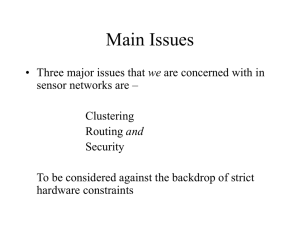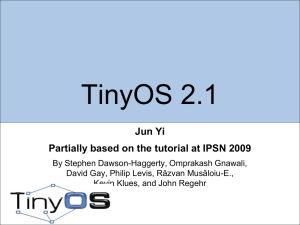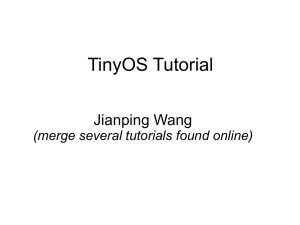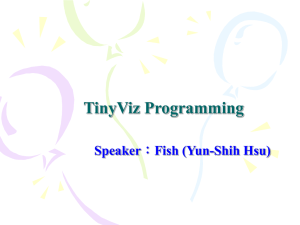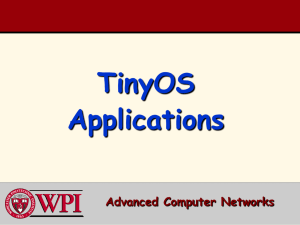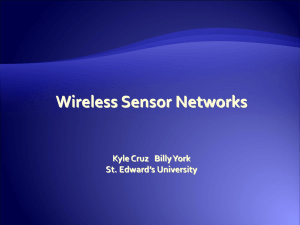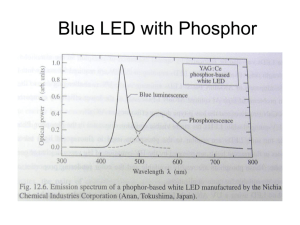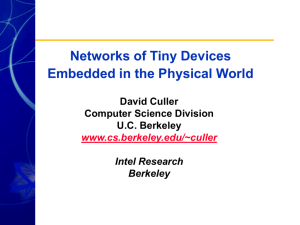ppt - Indriya Testbed at NUS
advertisement
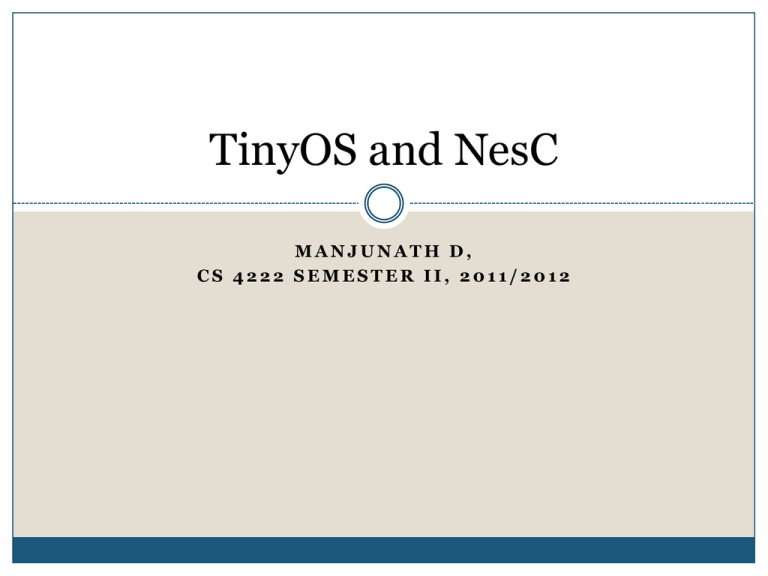
TinyOS and NesC
MANJUNATH D,
CS 4222 SEMESTER II, 2011/2012
Hardware: Motes and Sensors
Configuration of a typical mote
Sensors
TelosB
16-bit 8 MHz processor
10 KB RAM
Microcontroller (TIMSP430)
Smart dust
48 KB internal flash
12-bit ADC
Radio transceiver of 250 Kbps
2 AA batteries
SBT30 sensor
TinyOS and NesC: Installation
An overview of the steps involved in using TinyOS and NesC
PC-side
Install TinyOS and NesC
Write and compile your programs
Test your executables in a simulation environment
Finally, executables are loaded on to the mote devices
Mote-side
Loaded executables are executed on the mote devices
TinyOS and NesC: PC-Side Installation
On the PC-side, we encourage you to use Ubuntu
Linux: http://www.ubuntu.com/
A three-step process for installation
Edit the file “/etc/apt/sources.list” to include the following line
“deb http://tinyos.stanford.edu/tinyos/dists/ubuntu <version_name> main”
Command “lsb_release –a” will tell you the <version_name>
Execute commands
“apt-get update” and “apt-get install tinyos-2.1.1”
Set environment variables
Add the line “source /opt/tinyos-2.1.1/tinyos.sh” to “/home/xxx/.bashrc”
TinyOS and NesC: PC-Side Installation (Contd..)
Installation is somewhat painful on other OSs
Every package has to be installed manually
Details for Windows, Redhat Linux, and MAC can be found here
http://docs.tinyos.net/index.php/Getting_started
Learning Unix commands is inevitable as Cygwin is mandatory
on Windows so why not Ubuntu Linux ?
You can use Ubuntu Linux’s virtual image containing TinyOS
and NesC on Windows
http://docs.tinyos.net/index.php/Getting_started
TinyOS and NesC: PC-Side Installation (Contd..)
Directory structure
Parent directory
/opt/tinyos-2.1.1/
Applications
/opt/tinyos-2.1.1/apps/
System libraries
/opt/tinyos-2.1.1/tos/
Supporting tools
/opt/tinyos-2.1.1/support/
TinyOS: Design
Process management
Application plus OS is a single program and a single process
Application+OS
Main() { }
func1(){ }
func2(){ }
func3(){ }
func4(){ }
funcN(){ }
Image of a TinyOS Program
TinyOS: Design
Process management
Multiprocessing is expensive in terms of memory
RAM
0X00000
Process 1
Process 2
Process 3
Process N
stack
stack
stack
stack
Global variables (BSS)
Each process has to be allocated with a separate stack memory
Stack
TinyOS’s single stack
Only interrupts are allowed to preempt the execution
TinyOS: Design
Memory management
Virtual memory is not supported
Memory is not protected
File systems
Proposed file systems are not popular
TinyOS: Components
TinyOS is a library of components
A specific component implements a specific set of services
A component in turn can be a collection of sub-components
Routing
Network
MAC
Temperature
Light
Sensors
Microphone
Radio
USB
Flash
TinyOS
Leds
TinyOS: Components (Contd..)
Building an application over TinyOS
AppC
TinyOS
Routing
Network
MAC
Temperature
Light
Sensors
Microphone
Radio
USB
Flash
Leds
TinyOS: Components (Contd..)
Component interfaces
Component services are accessed via interfaces
Send
Network
Receive
TinyOS: Components (Contd..)
Interface commands
Instruct components to perform its specific tasks
getTemperature
getLight
Sensors
SampleSensors
getMagnetometer
getAccelerometer
TinyOS: Components (Contd..)
Interface events
Applications are responsible for specifying an action on an
occurrence of an event
Network
Receive
PacketReceive
Application
Send
sendDone
Application
Events are also essential as system calls in TinyOS
are non-blocking
TinyOS: Components (Contd..)
A few commonly used TinyOS components
LedsC
TimerC
ActiveMessageC
Some components to sample sensors
TinyOS: Components (Contd..)
LedsC
Allows to control the 3 LEDS on the motes
Provided interfaces
Leds
Commands
•
•
•
•
•
•
led0Toggle()
led1Toggle()
led2Toggle()
ledoOn
led0Off
………
TinyOS: Components (Contd..)
TimerC
Lets to carryout a task after a specified interval or periodically
Provided interfaces
Timer
Commands
•
•
•
•
startPeriodic(int period_millisec)
startOneShot(int period_millisec)
stop()
……
Events
• fired()
TinyOS: Components (Contd..)
ActiveMessageC (TinyOS’s Network component)
Allows to communicate over the radio
Provided interfaces
AMSend
Commands
• send(destination, packet, size)
Events
• sendDone(packet, error)
Receive
Events
• receive(packet, payload, size)
NesC: Design
NesC is designed to implement TinyOS components
NesC is a pre-processor to the C compiler
NesC program
NesC preprocessor
C program
C compiler (gcc)
Binary for the mote platform
NesC Compilation Process
NesC Programs over TinyOS
The best way to learn NesC is to dig into a few
examples of NesC programs over TinyOS
Hello-world program
A simple application that toggles (blinks) the red LED on a
mote once in every 2 seconds
Configuration component
components LedsC, TimerC,
MainC;
components BlinkC;
implementation {
BlinkC.Leds -> LedsC;
BlinkC.Timer -> TimerC;
BlinkC.Boot -> MainC;
}
LedsC
interfaces: Leds
commands:
led0Toggle()
led1Toggle()…..
TimerC
interfaces: Timer
commands:
startPeriodic()
events:
fired()
Module component (BlinkC)
uses {
interface Leds;
interface Timer;
interface Boot;
}
implementation {
event Boot.booted()
{
call Timer.startPeriodic(2000) ;
}
event Timer.fired()
{
call Leds.led0Toggle() ;
}
}
NesC Programs over TinyOS (Contd..)
Compile and upload the Blink application
Include a Makefile containing the following two lines
COMPONENT=BlinkAppC
include $(MAKERULES)
Compilation
Type make telosb in the same directory where the Makefile and your
application components are located
Uploading an exe image on to a mote
Type make telosb reinstall.NODEID bsl,addr_usb_port in the same
directory
Command “motelist” will give you the addr_usb_port
e.g., make telosb reinstall.1 bsl,/dev/ttyUSB0
NesC Programs over TinyOS (Contd..)
A simple networking example
A packet is communicated from a sender to a receiver with the
sender turning ON the red LED after transmission and the
receiver switches ON the green LED on receiving the packet
Configuration component
components ActiveMessageC,
LedsC, MainC;
ActiveMessageC
interface: AMSend
commands: send()
events: sendDone()
interface: Receive
events: receive ()
interface: SplitControl
commands: start()
events: startDone()
LedsC
interfaces: Leds
commands:
led0Toggle()
led1Toggle()…..
Module component
uses {
interface AMSend;
interface Receive;
interface SplitControl;
interface Boot;
}
implementation {
message_t packet;
event Boot.booted()
{
call SplitControl.start()
}
event SplitControl.startDone()
{
call AMSend.send(2, &packet, 10);
}
Configuration component
Module component
components ActiveMessageC,
LedsC, MainC;
event AMSend.sendDone(packet, error)
{
if(error == SUCCESS) {
call Leds.led0On();
}
else {
// Retransmit if you need
}
}
ActiveMessageC
interface: AMSend
commands: send()
events: sendDone()
interface: Receive
events: receive ()
interface: SplitControl
commands: start()
events: startDone()
LedsC
interfaces: Leds
commands:
led0Toggle()
led1Toggle()…..
event Receive.recevie(packet, payload,
size)
{
call Leds.led1On();
}
}
Configuration component
components ActiveMessageC,
LedsC, MainC;
components NetC;
implementation {
NetC.AMSend ->
ActiveMessageC.AMSend;
NetC.Receive ->
ActiveMessageC.Receive;
NetC.SplitControl ->
ActiveMessageC;
NetC.Boot -> MainC;
}
Module component (NetC)
uses {
interface AMSend;
interface Receive;
interface SplitControl;
interface Boot;
}
implementation {
message_t packet;
event Boot.booted()
{
call SplitControl.start()
}
event SplitControl.startDone()
{
call AMSend.send(2, &packet, 10);
}
Configuration component
components ActiveMessageC,
LedsC, MainC;
components NetC;
implementation {
Module component (NetC)
uses {
interface
interface
interface
interface
}
AMSend;
Receive;
SplitControl;
Boot;
NetC.AMSend ->
ActiveMessageC.AMSend;
NetC.Receive ->
ActiveMessageC.Receive;
NetC.SplitControl ->
ActiveMessageC;
NetC.Boot -> MainC;
}
event Receive.recevie(packet, payload,
size)
{
call Leds.led1On();
}
Configuration component
components ActiveMessageC,
LedsC, MainC;
components NetC;
implementation {
Module component (NetC)
uses {
interface
interface
interface
interface
}
AMSend;
Receive;
SplitControl;
Boot;
NetC.AMSend ->
ActiveMessageC.AMSend [240];
NetC.Receive ->
ActiveMessageC.Receive[240];
NetC.SplitControl ->
ActiveMessageC;
NetC.Boot -> MainC;
}
event Receive.recevie(packet, payload,
size)
{
call Leds.led1On();
}
NesC Programs over TinyOS (Contd..)
An example of serial communication over USB
Send a command from a PC to a mote that triggers the mote to
send a packet back to the PC (PC
mote communication)
SF-client
SF
SF protocol
SF-client
PC
Required set-up for serial communication
mote
NesC Programs over TinyOS (Contd..)
Executing serial communication programs on the
PC-side
SF is a gateway program that lets multiple clients to
communicate with a mote
./sf tcp_port_num usb_dev_addr telosb
Two programs constituting the SF-client
./send host_addr sf_port_num input_values
./receive host_addr sf_port_num
These programs are available in C, Python, and Java
You do not have to learn any of these languages – knowing to
execute their programs is sufficient !!!!
NesC Programs over TinyOS (Contd..)
TinyOS component to be used on the mote-side
SerialActiveMessageC (Very similar to the ActiveMessageC)
Provided interfaces
AMSend
Receive
SplitControl
Configuration component
components
SerialActiveMessageC,
Module component (SerialC)
uses {
components SerialC, LedsC, MainC;
implementation {
interface AMSend;
interface Receive;
SerialC.AMSend ->
interface SplitControl;
SerailActiveMessageC.AMSend[240];
SerialC.Receive -> SerialActiveMessageC.Receive[240];
SerialC.SplitControl ->
SerialActiveMessageC;
SerialC.Boot -> MainC;
}
event AMSend.sendDone(packet, error)
{
if(error == SUCCESS) {
call Leds.led0On();
}
else {
// Retransmit if you need
}
}
}
interface Boot;
}
implementation {
message_t packet;
event Boot.booted()
{
call SplitControl.start();
}
event SplitControl.startDone()
{
}
event Receive.recevie(packet, payload, size)
{
call Leds.led1On();
call AMSend.send(addr, &packet, 10);
}
Programming Assignment 1
A simple application aimed to warm you up for more
programming on TinyOS/NesC
Students mainly learn
Basic architecture of TinyOS/NesC
Compilation and downloading of TinyOS code on to motes
PC<->Mote communication
Application is to turn a desired LED(s) ON/OFF for a
desired duration of time
Application involves programming on both PC- and
mote-side
Programming Assignment 1 (Contd..)
PC-side
Design a client that communicates a few parameters to the
mote and displays messages received from the mote
A command line interface is sufficient, no need for GUI
Mote-side
Program should receive the parameters that the client
transmits and send an ACK back to the client
LEDS must be controlled as instructed by the input
parameters
Programming Assignment 1 (Contd..)
Submission
Submit your code zipped/tarred to IVLE workbin
The code should be compilable and include a README file
explaining how to compile and how the program works
Grading
25 points – Correct choice of components and compilation
25 points – PC to mote communication
25 points – Mote to PC communication
25 Points – Desired control of LEDS
Weightage towards final assessment is 5%
